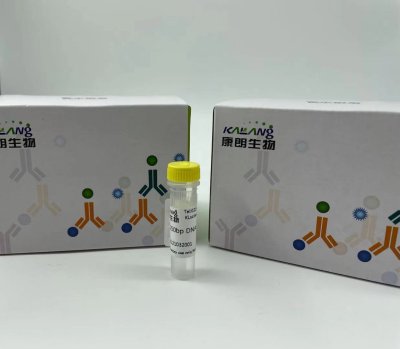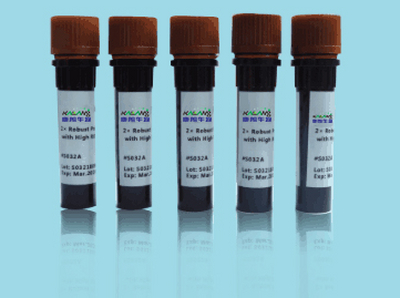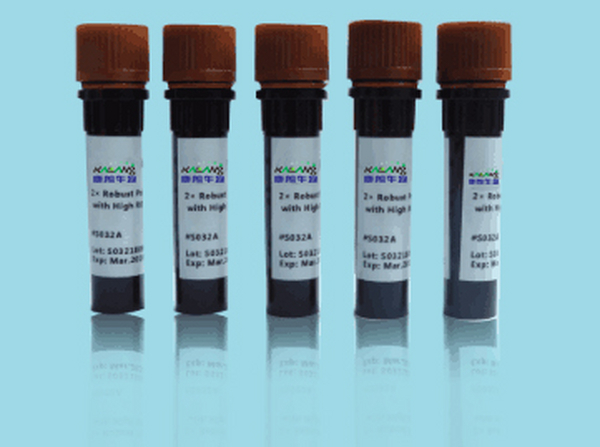QQ:3002763590


客服电话:021-61998208
EMR2 rabbit Polyclonal Antibody
EMR2抗体
EMR2抗体应用:Western Blot: 1/500 - 1/2000. IHC-p: 1:100-1:300. ELISA: 1/10000. adhesion G protein-coupled receptor E2(ADGRE2) Homo sapiens This gene encodes a member of the class B seven-span transmembrane (TM7) subfamily of G-protein coupled receptors. These proteins are characterized by an extended extracellular region with a variable number of N-terminal epidermal growth factor-like domains coupled to a TM7 domain via a mucin-like spacer domain. The encoded protein is expressed mainly in myeloid cells where it promotes cell-cell adhesion through interaction with chondroitin sulfate chains. This gene is situated in a cluster of related genes on chromosome 19. Alternatively spliced transcript variants encoding multiple isoforms have been observed for this gene. [provided by RefSeq, Aug 2012],
EMR2 rabbit Polyclonal Antibody
EMR2抗体
EMR2抗体应用:Western Blot: 1/500 - 1/2000. Immunofluorescence: 1/200 - 1/1000. ELISA: 1/20000. adhesion G protein-coupled receptor E2(ADGRE2) Homo sapiens This gene encodes a member of the class B seven-span transmembrane (TM7) subfamily of G-protein coupled receptors. These proteins are characterized by an extended extracellular region with a variable number of N-terminal epidermal growth factor-like domains coupled to a TM7 domain via a mucin-like spacer domain. The encoded protein is expressed mainly in myeloid cells where it promotes cell-cell adhesion through interaction with chondroitin sulfate chains. This gene is situated in a cluster of related genes on chromosome 19. Alternatively spliced transcript variants encoding multiple isoforms have been observed for this gene. [provided by RefSeq, Aug 2012],
EMR2 rabbit Polyclonal Antibody
EMR2抗体
EMR2抗体应用:Western Blot: 1/500 - 1/2000. Immunofluorescence: 1/200 - 1/1000. ELISA: 1/10000. adhesion G protein-coupled receptor E2(ADGRE2) Homo sapiens This gene encodes a member of the class B seven-span transmembrane (TM7) subfamily of G-protein coupled receptors. These proteins are characterized by an extended extracellular region with a variable number of N-terminal epidermal growth factor-like domains coupled to a TM7 domain via a mucin-like spacer domain. The encoded protein is expressed mainly in myeloid cells where it promotes cell-cell adhesion through interaction with chondroitin sulfate chains. This gene is situated in a cluster of related genes on chromosome 19. Alternatively spliced transcript variants encoding multiple isoforms have been observed for this gene. [provided by RefSeq, Aug 2012],
EMR3 rabbit Polyclonal Antibody
EMR3抗体
EMR3抗体应用:Western Blot: 1/500 - 1/2000. Immunofluorescence: 1/200 - 1/1000. ELISA: 1/10000. adhesion G protein-coupled receptor E3(ADGRE3) Homo sapiens This gene encodes a member of the class B seven-span transmembrane (TM7) receptor family expressed predominantly by cells of the immune system. Family members are characterized by an extended extracellular region with a variable number of N-terminal epidermal growth factor (EGF)-like domains coupled to a TM7 domain via a mucin-like spacer domain. This gene is closely linked to the gene encoding egf-like molecule containing mucin-like hormone receptor 2 on chromosome 19. This protein may play a role in myeloid-myeloid interactions during immune and inflammatory responses. Alternative splicing results in multiple transcript variants encoding different isoforms. [provided by RefSeq, Jan 2014],
EMR4 rabbit Polyclonal Antibody
EMR4抗体
EMR4抗体应用:Western Blot: 1/500 - 1/2000. Immunofluorescence: 1/200 - 1/1000. ELISA: 1/20000. adhesion G protein-coupled receptor E4, pseudogene(ADGRE4P) Homo sapiens This gene is a member of the EGF-TM7 receptor gene family which is thought to play a role in leukocyte adhesion and migration. In other vertebrates, including nonhuman primates, this gene encodes a protein containing N-terminal EGF domains and a C-terminal transmembrane domain. Sequence evidence for the human gene, however, indicates nucleotide deletion in the genomic sequence would result in frameshift and early termination of translation. A protein expressed by this gene would be soluble rather than expressed on the cell surface. As the encoded protein has not been detected, this gene may represent a transcribed pseudogene. [provided by RefSeq, Aug 2008],
Emx1 rabbit Polyclonal Antibody
Emx1抗体
Emx1抗体应用:Western Blot: 1/500 - 1/2000. ELISA: 1/40000. function:Transcription factor, which in cooperation with EMX2, acts to generate the boundary between the roof and archipallium in the developing brain. May function in combinations with OTX1/2 to specify cell fates in the developing central nervous system.,similarity:Belongs to the EMX homeobox family.,similarity:Contains 1 homeobox DNA-binding domain.,tissue specificity:Cerebral cortex.,
Emx2 rabbit Polyclonal Antibody
Emx2抗体
Emx2抗体应用:Immunohistochemistry: 1/100 - 1/300. ELISA: 1/20000. empty spiracles homeobox 2(EMX2) Homo sapiens This gene encodes a homeobox-containing transcription factor that is the homolog to the 'empty spiracles' gene in Drosophila. Research on this gene in humans has focused on its expression in three tissues: dorsal telencephalon, olfactory neuroepithelium, and urogenetial system. It is expressed in the dorsal telencephalon during development in a low rostral-lateral to high caudal-medial gradient and is proposed to pattern the neocortex into defined functional areas. It is also expressed in embryonic and adult olfactory neuroepithelia where it complexes with eukaryotic translation initiation factor 4E (eIF4E) and possibly regulates mRNA transport or translation. In the developing urogenital system, it is expressed in epithelial tissues and is negatively regulated by HOXA10. Alternative splicing results in multiple transcript variants encoding distinct proteins.[provided by RefSeq,
ENA-78 rabbit Polyclonal Antibody
ENA-78抗体
ENA-78抗体应用:IHC-p 1:50-200, ELISA 1:10000-20000 C-X-C motif chemokine ligand 5(CXCL5) Homo sapiens This gene encodes a protein that is a member of the CXC subfamily of chemokines. Chemokines, which recruit and activate leukocytes, are classified by function (inflammatory or homeostatic) or by structure. This protein is proposed to bind the G-protein coupled receptor chemokine (C-X-C motif) receptor 2 to recruit neutrophils, to promote angiogenesis and to remodel connective tissues. This protein is thought to play a role in cancer cell proliferation, migration, and invasion. [provided by RefSeq, May 2013],
ENaC β rabbit Polyclonal Antibody
ENaC β抗体
ENaC β抗体应用:WB 1:500-2000 Immunohistochemistry: 1/100 - 1/300. Immunofluorescence: 1/200 - 1/1000. ELISA: 1/20000. sodium channel epithelial 1 beta subunit(SCNN1B) Homo sapiens Nonvoltage-gated, amiloride-sensitive, sodium channels control fluid and electrolyte transport across epithelia in many organs. These channels are heteromeric complexes consisting of 3 subunits: alpha, beta, and gamma. This gene encodes the beta subunit, and mutations in this gene have been associated with pseudohypoaldosteronism type 1 (PHA1), and Liddle syndrome. [provided by RefSeq, Apr 2009],
ENaC γ rabbit Polyclonal Antibody
ENaC γ抗体
ENaC γ抗体应用:Western Blot: 1/500 - 1/2000. ELISA: 1/20000. sodium channel epithelial 1 gamma subunit(SCNN1G) Homo sapiens Nonvoltage-gated, amiloride-sensitive, sodium channels control fluid and electrolyte transport across epithelia in many organs. These channels are heteromeric complexes consisting of 3 subunits: alpha, beta, and gamma. This gene encodes the gamma subunit, and mutations in this gene have been associated with Liddle syndrome. [provided by RefSeq, Apr 2009],
最新动态
-

Anti-GNGT1 KL20092-001(50ul)
2021-10-11 -

Anti-GNGT1 antibody(50ul) KL20093-001
2021-10-11 -

MUC5AC (PT2058) mouse Monoclonal Antibody
2021-01-06 -

mOrange mouse Monoclonal Antibody(Mix)
2021-01-05
热门标签
- Histone H3 rabbit Polyclonal Antibody Histone H3抗体
- EGFR rabbit Polyclonal Antibody EGFR抗体
- Cy3 Conjugated
- AbFluor™ 555 Conjugated
- AbFluor™ 680 Conjugated
- AbFluor™ 350 Conjugated
- AbFluor™ 647 Conjugated
- AbFluor™ 594 Conjugated
- AbFluor™ 405 Conjugated
- Cy5 Conjugated
- AbFluor™ 488 Conjugated
- Cyclophilin B抗体 Cyclophilin B Monoclonal Antibody(2B10)
- COX IV抗体 COX IV Monoclonal Antibody(6C8)
- PCNA抗体 PCNA Monoclonal Antibody(12D10)
- FAK rabbit Polyclonal Antibody FAK抗体
邮箱:3002763590@qq.com
电话:021-61998208

扫码关注微信公众号






